Shevlin Sebastian's Blog, page 61
January 10, 2018
Captain Radhika Menon Wins Union Ministry Award
 By Shevlin Sebastian
By Shevlin SebastianCaptain Radhika Menon is on a roll. The first female captain of the Indian Merchant Navy has bagged another award. This time, the Ministry of Women and Child Development is presenting a 'First Ladies' Award to her at a function at Rashtrapati Bhavan on January 20. A ministry communication stated: 'This is an initiative to recognise women who had the courage to tread an unusual path and succeeded in being the first in their respective professions. Our aim is to empower and encourage the women of our country.”
Earlier, Radhika had won the International Maritime Organisation (IMO) Award for Exceptional Bravery at Sea. This is for her role in the rescue of seven fishermen from a sinking fishing boat off the coast of Orissa on June 22, 2015. She is also the first woman to win this award. It was presented to Radhika at a function of the IMO at London on November 21, 2016.
At that time, Radhika had said, “To be honest, I was not trying to win an award when I initiated the rescue operation. Instead, I considered it my duty. But, yes, the recognition from the IMO is memorable and I am humbled and honoured.”
On April 5, 2016, National Maritime Day, the National Maritime Day Celebration Committee of India conferred the 'Seafarers Gallantry Award' on her.
Radhika was appointed as captain in early 2013 and usually, she handles an all-male crew. “They know me well, and have no problems in taking orders from me,” she says. “Do remember I have been with the Shipping Corporation of India (SCI) for about 26 years.” Radhika did a one-and-a-half year radio course at the All India Marine College in Kochi before she became a radio officer in SCI, the first woman to do so in India.
But it has not been a smooth journey. “As compared to a male officer, I am scrutinised much more,” she says. “I try to avoid making mistakes. If I do make one, it will be talked about, and never forgotten. My attitude is simple: if a hurdle has been placed in front of you, then you will have to clear it.”
(The New Indian Express, Kochi and Thiruvananthapuram)
Published on January 10, 2018 21:32
January 9, 2018
Losing Expensive Cameras
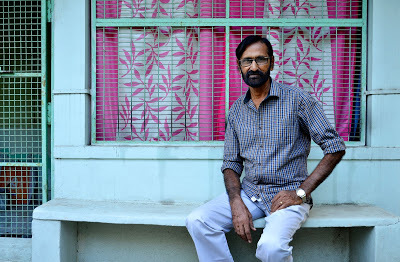
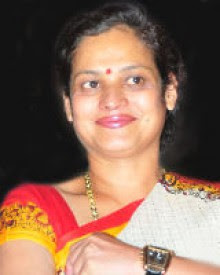 COLUMN: LOCATION DIARY
COLUMN: LOCATION DIARYPhotographer MK Mohanan (Momi) talks about his experiences in the films, 'Mandanmar Londonil', 'Kinnaram', 'Revathikkoru Pavakkutty', 'Lal Americayil', and 'Veendum Chila Veettukaryangal'
Photo of Momi by Sunish P Surendran; the dancer Disco Shanti
By Shevlin Sebastian
For the film, 'Mandanmar Londonil' (1983), stills photographer MK Mohanan (Momi) made his first trip to London. The crew sailed through immigration but it was only when they waited outside, they realised that director Sathyan Anthikad and cinematographer Anandakuttan had not come out.
After a while, they came to know the reason. “On their passport, Sathyan was described as a director and Anandakuttan as a cameraman,” says Momi. “At that time most of the directors in England were middle-aged or senior people, so they could not believe that Sathyan, at just 28 years of age, was a director.”
Eventually, the London-based producer Mohan had to go to his home, get the official letterheads of his film company and was able to prove that Sathyan and Anandakuttan were indeed director and cameraman respectively.
Scenes from life
In 'Kinnaram' (1983), there was a scene between Unni (Nedumudi Venu) and Sethu (Sukumaran), who are two bachelor friends staying together in Chennai. While Sukumaram wanted to sleep, Venu wanted to read. So they kept switching on and off the lights, in turns.
“As I was watching this scene, it looked familiar,” says Momi. “Sathyan and I would sleep together when we were youngsters and while he wanted to read, I wanted to sleep. So, I would switch off the light and he would put it on. He took the inspiration from our lives.”
There were many such incidents which Sathyan had put in ‘Kinnaram’. So, one day Momi told him, “Sathyan if the film does well, you have to share the profits with me, because you have lifted it straight from our lives and making money out of it.”Sathyan laughed aloud.
But working in 'Revathikkoru Pavakkutty' (1986) was no laughing matter for Momi. The song, ‘Chinnakkutti Chellakkutti Thankakkatti’ was being shot at a lake in Cherthala. After taking some stills, Momi hired a small boat and moved away, to get a long distance shot.
Momi had three cameras around his neck – a Mamiya, Canon, and a Rolleiflex. But on the small boat, Momi was finding it difficult to retain his balance. And the inevitable happened. The boat toppled over and Momi fell into the water. But since Momi knew swimming he did not panic. But he immediately raised the three cameras out of the water.
“Sathyan later told me later that he first saw the three cameras coming out of the water, followed by my head,” says Momi. “He said he would never forget that image.”
Unfortunately, there was significant damage. The Rolleiflex priced at Rs 5000, and the Mamiya at Rs 6000 could not be repaired. “It was a financial blow for me,” says Momi.
In the film, 'Lal Americayil' (1989), it was the turn of dancer Disco Shanti to have problems with the water. There was a scene in a swimming pool. Shanti was supposed to dive into the pool from a diving board. Momi stepped into the pool to watch Shanti jump.
And jump she did. But after that, she did not come up to the surface. Momi immediately swam to where she was lying immobile at the bottom. He managed to pull her up to the surface, where crew members dragged her to out of the pool and revived her.
“I had drunk a lot of water, but I was so glad I could save her life,” says Momi. Soon, they came to know that Shanti did not know swimming. Earlier, when she had been informed that it was a movie where swimming would be required, she kept quiet in order to get the role.
Recovering from a trauma
The shoot for the film 'Veendum Chila Veettukaryangal' (1999) was taking place at Ottapalam soon after the death of director Bharathan, on July 30, 1998. Bharathan's wife KPAC Lalitha had a major role. But nobody was sure whether she would be able to perform.
The shoot was of a scene between her and Nedumudi Venu. “In real life, Bharathan and Lalitha were very close to Venu and his family,” says Momi. “Following Bharathan's passing, Lalitha had not seen Venu.”
But when Lalitha met Venu, she lost control and began crying. And she did not stop for a long time. Venu tried to console her but to no avail. “The shoot was cancelled,” says Momi. “But after a couple of days, Lalitha managed to regain her composure and resumed work.”
(The New Indian Express, Kochi, Kozhikode and Thiruvananthapuram)
Published on January 09, 2018 20:50
January 5, 2018
Art impresario Asif Ali has curated his 100th exhibition, ‘Chithra Chantha’ (Art Mart)
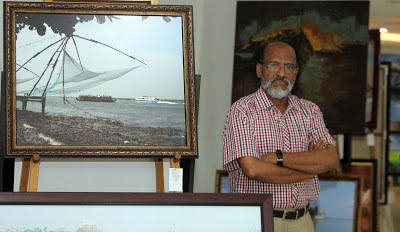

By Shevlin Sebastian
Photo of Asif Ali by Melton Antony; the participating artists
In 1993, art impresario Asif Ali was preparing to hold a cultural show at the poolside auditorium of Al-Nasr Leisureland, Dubai. One of the participating artists, Gokulan Thrissur did a painting of the back of a woman who was playing the veena. Asif got it hung as a backdrop.
When a senior plainclothes policeman, who had come to inspect the auditorium, saw the backdrop, he said that this was not allowed. So, he went to get more policemen, so that he could arrest Asif.
“I did not know that in the UAE (United Arab Emirates) you could not draw pictures of a woman, and put it up in public,” says Asif. “But now I was in danger of being imprisoned.”
But a quick-thinking Asif told Gokulan to make the girl’s head like a sun and the veena like a mountain. After half an hour when the policeman returned with a couple of his colleagues, the painting was completely changed.
The policeman looked shocked. Then he smiled, shook his head, and said, “You Indians are too talented.”
The show was allowed to go ahead and it was a success. Emboldened, in 1994, Asif decided to go ahead with his first painting exhibition at Sharjah. The works of five artists were showcased. Among them was Asif’s younger brother Riyas Komu, who, later, along with fellow artist Bose Krishnamchari founded the Kochi Muziris Biennale in December, 2012.
Asif recounted all this while he stood among paintings of his 100th exhibition called ‘Chithra Chantha’ (Art Mart), which he has organised with cartoonist Ibraham Badhusha at the Oberon Mall at Kochi. More than 100 artists are taking part, showcasing more than 250 paintings, woodworks, photographs and sculptures.
Among them are paintings by Sindhu, the wife of the late Mollywood director Lohithadas, actress Sheela, and Vinitha Anand, the granddaughter of the legendary artist Raja Ravi Varma. Mainstream artists like Jimmy Mathew, Dudu Unni, Sara Hussain and Raveendran Valappad are also taking part.
Some artists have different reasons for taking part. Renjith Thekkoote wants to build a house from the money that he earns by selling his works at the exhibition. Two artists are in hospital: Johnson Aluva and Ummer Thathapilly. “They are hoping to get buyers for their their works, so that they can pay the hospital bills,” says Asif.
As Asif talks, small groups of people step into the exhibition area on the fifth floor. “Art is catching on among ordinary people,” he says. “Those who build new homes would like to put up works of art. The Biennale has also made a difference.”
But Asif readily admits that cinema is the first love of the people. “When you watch a film, you can follow the story,” he says. “And it is usually stories about the people we know and hence can relate to. However, when you look at an art work, there are many stories but they remain hidden within the canvas. In fact, when you look at a work, you have to make up your own story. And that is not easy.”
Nevertheless, that has never discouraged Asif. After spending more than twenty years in Sharjah, working in the advertising and marketing sectors, Asif settled down in Aluva and started the Komusons Art Gallery in 2007. Thus far, he has held exhibitions in Thiruvananthapuram, Thrissur, Kodungallur, Kochi, Nedumbassery and Fort Kochi. “I enjoy encouraging artists,” he says.
When asked about their character, Asif says, “They are moody and over-sensitive. Most of them are loners. They tend to avoid conflicts. For them, art is a passion. They are looking for creative fulfillment. When they start a work, they forget the outside world and concentrate deeply. They will only reconnect with others after the work is over. Their satisfaction comes from the work. It is not that they create works of art because they want to sell them. In fact, most artists are poor at marketing. In Mumbai, there are curators who do the marketing. In Kerala, this is where I come in.”
Apart from being an art promoter, Asif has been a photographer, and produced and directed numerous TV commercials, radio advertisements, documentaries, songs, and serials, apart from cultural programmes. “Life is short,” says the 67-year-old. “I want to make the most of it.”
(The New Indian Express, Kochi, Thiruvananthapuram and Kozhikode)
Published on January 05, 2018 21:53
January 3, 2018
Usha Uthup's Musician Colleague Emile Isaacs Passes Away
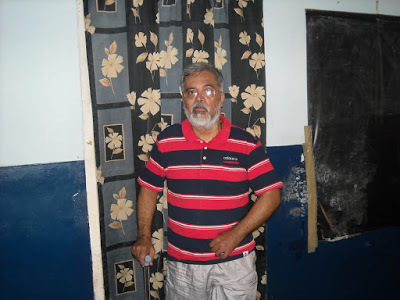 By Shevlin Sebastian
By Shevlin SebastianThe ace musician Emile Isaacs passed away at 1.30 p.m. at the Medical Trust Hospital, Kochi on January3. He was 70 years old. He had been suffering from diabetes, kidney-related ailments as well as breathing difficulties. With his passing, one more stellar musician goes missing from Kochi as well as India's music scene.
Emile had been the bass guitarist for 'The Sound' band, which accompanied Usha Uthup in all her performances. “I had been with Usha for 38 years,” he had told this reporter a few years ago. They have performed all over the world, including offbeat places like Uzbekistan and Kazakhstan.
Unfortunately, in January, 2009, during a concert in Kolkata, Emile could feel his hand becoming numb. It was the beginning of a stroke. And it affected the movement of his left arm and leg. Unfortunately, it brought his career to a halt.
Emile, the son of a prominent violinist, Joe Isaacs, started playing the guitar at 15. Because of his natural talent, he was hired as a member of playback singer K.J. Yesudas' band. They performed all over Kerala and in the Middle East. “Yesudas made me,” Emile said. “I was with the band for eight years.”
Later, Emile started a band called the Elite Aces, which consisted of his brothers, Eugene, Rex, and cousin Pinson Correia. They began playing at Volga, Sealord, and the Casino hotels at Kochi. Soon, they became popular.
When Usha came down from Mumbai, at the invitation of the Kottayam Arts Society, the Elite Aces performed for her. “This was our first concert with Usha,” said Emile. They clicked together and played for a number of years. However, in 1979, the Elite Aces broke up and the band members went their different ways, while Emile stayed on with Usha, at Kolkata.
Today, a sombre Usha says, “I am totally grieved about the passing of Emile. He has been a part of my career for so many years. It was fantastic the kind of music we used to do. And, over the decades, we graduated from one genre to another. He was a great musician as well as a wonderful friend.”
(The New Indian Express, Kerala edition)
Published on January 03, 2018 22:20
January 2, 2018
Manufacturing A Dam
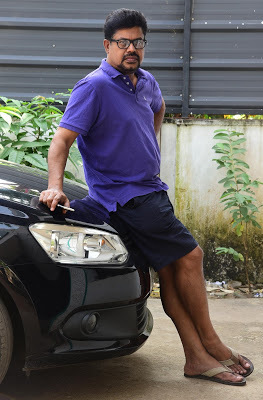 COLUMN: LOCATION DIARY
COLUMN: LOCATION DIARYScriptwriter Shibu Chakravarthy talks about his experiences in the films, ‘Ooru Thira Pinnayum Thira’, ‘Nair Saab’, ‘Sainyam’ and ‘Churam’
Photo by Albin Mathew
By Shevlin Sebastian
Scriptwriter Shibu Chakravarthy was only fifteen years old when he went to the sets of P. G. Viswambharan’s ‘Ooru Thira Pinnayum Thira’ (1982) at Aluva. That was because Viswambharan was married to Shibu’s cousin, Meena. “I was supposed to go and give some medicine to him,” says Shibu.
When Shibu reached the location he saw the actors Prem Nazir and Jaya Bharathi. Viswambharan told Shibu, “Do you want a photo with Prem Nazir?”
But Shibu was not interested. “I was not much of a Prem Nazir fan,” he says. “But the person who I found most interesting was a handsome, young man who was operating the camera. He was Jayanan Vincent. I was introduced to Jayanan. He was just a few years older than me.”
It was a fateful meeting. Because, in later years, Shibu and Jayanan worked on many films, including ‘Nair Saab’ (1989).
In ‘Nair Saab’, a large portion of the film was shot in Kashmir. Shibu remembers travelling on a snow truck from Srinagar to Gulmarg in December when it was snowing heavily.“The wheels had chains on them,” says Shibu. “Snow is like cotton. But when weight is put on it, the snow turns into ice. As the driver braked, the wheels went on slipping for a while. The problem was that on one side of the road it was a steep slope. I felt so nervous.”
Anyway, they reached safely. But there was a crisis. In the film, there is a scene where a house had to be exploded. But everywhere there were signs which stated that nobody should clap their hands or shout as it would trigger an avalanche. “So, we could not get permission to do an explosion,” says Shibu.
Then the crew decided to make a miniature model. It would be one-eighths of the actual size. “Next to our hotel, there was a house,” says Shibu. “We took some shots. Then I made some sketches and added a few fir trees.”
In the end, a miniature house was created on a table at Chennai’s AVM Studio. “We used salt to recreate the snow,” says a smiling Shibu. “I think it worked because when you see the film, you will not notice the difference.”
After the Kashmir shoot was over, director Joshiy and Shibu were flying from Delhi to Bangalore. As the plane neared Bangalore, both of them saw numerous runways belonging to the Air Force.
Joshiy said, “Shibu, our next film should do should be on the Air Force. You think about a story.”
Shibu got cracking and wrote the script for ‘Sainyam’ (1994). The shoot, at the Air Force Academy at Dundigal, near Hyderabad, was originally scheduled for November but Mammootty got chicken pox. So the shoot was postponed to March. “At that time, the temperature at Dundigal was 40 degrees Celsius but at the Academy, it must have been two degrees more since there were no trees around because there were 60 runways on 5000 acres of land,” says Shibu.
As soon as there was a break in the shoot, everybody went and stood under the shade of the two-seater plane which was being used in the shoot. “But I saw too many young crew members get sun-stroke and fall on the tarmac,” he says. “It was such a stunning contrast to what we experienced in Kashmir.”
However, on the sets of ‘Churam’ (1997), it was all about water. The climax was supposed to be a flood coming down a mountain. But when Bharathan and the art director tried to make a set, it did not work. The producer was S Satheesh, a member of a dam-building firm.
“Satheesh said that their engineers would make a dam,” says Shibu. “To reach the top of a mountain, near Thenmala, they made a road.” Thereafter, they made a mini dam. Through pipes, the water was sent up. Then shutters were made. “When the crew was ready, the engineers opened the shutters and the water came rushing down the mountain,” says Shibu. “It turned out to be a superb climax.”
(The New Indian Express, Kochi, Thiruvananthapuram and Kozhikode)
Published on January 02, 2018 21:49
December 31, 2017
This Is What We Wish In 2018, But Will It Happen?
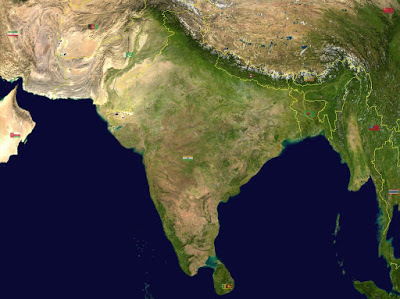 By Shevlin Sebastian
By Shevlin SebastianIn 2018, if any natural disaster takes place we would like the Kerala state government to get the number of victims correctly so that no family misses out on the compensation.
We want that when we say our name, people should not categorise us as Hindu, Muslim, Christian, Jain, or whatever, and put us into the mental boxes of accommodation or discrimination. Instead, can we rise above caste and creed and look at each other as fellow Indians?
We want that when a woman complains of misogyny, we don’t want hundreds of bricks thrown online at her.
We want doctors to regain their focus on healing people instead of having a mercenary attitude all the time.
We want those who spew hatred against people of other communities, to realise that despite the differences in upbringing, education, religious beliefs and thought processes, the same red blood flows in their veins as it does in the ‘other’.
We want drivers – of cars, buses, auto-rickshaws and two-wheelers – to understand that when they blow their horns non-stop it gets on the nerves of others, especially the elderly.
We want that if a boy student puts his arm around a girl classmate it should not result in condemnation and expulsion. We want a relaxation of the rules. Too many decades of sexual repression has led to an alarming rise in child sex abuse cases and perversions.
We want the culture of black money and illegal transactions to be ended, so that honest entrepreneurs can also thrive.
We want the young to realise that drug-taking and excess alcohol ruins their brains and bodies and damages their future.
We want women to be treated with dignity and respect at their work places, on the streets, in malls and market-places, at their homes and while travelling on a public transport.
We want a visit to a police station to be not one of intimidation and harassment but of co-operation and friendliness.
So, can we, as fellow Indians, fulfill these wants and make the world a better place?
(The New Indian Express, Kerala editions)
Published on December 31, 2017 21:50
December 26, 2017
Crash, Bang, Thud!
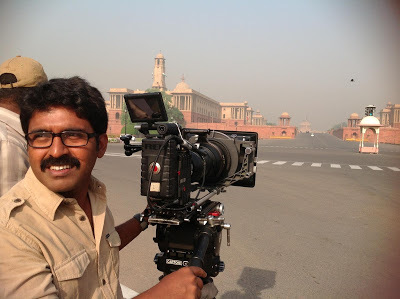
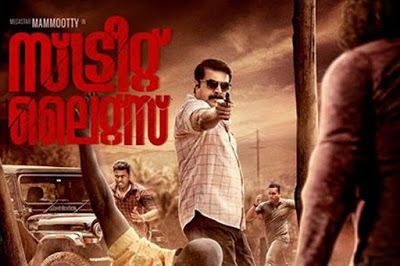 COLUMN: LOCATION DIARY
COLUMN: LOCATION DIARYCinematographer Shamdat talks about his experiences in the films, ‘Sahasam’, ‘Prasthanam’ and ‘Streetlights’
Photos: Shamdat at a location; the poster of 'Streetlights'
By Shevlin Sebastian
In the Telugu action film ‘Sahasam’ (2013), there is a car chase on a mountainous road in Ladakh. One car was supposed to hit a fallen bike and then veer away and fall off the mountainside. “We placed four cameras at different locations,” says cinematographer Shamdat.
Then he placed one camera, 150 feet below so that he could capture the fall of the vehicle. But the director Chandra Sekhar Yeleti told Shamdat it looked a bit risky. “I said that when the vehicle falls it will bounce a bit and come to a stop because there is a hole there,” says Shamdat. “If we get it, we will have a Hollywood type action shot.”
The fight master Stunt Silva told Shamdat that in case something went wrong, he should move to the left and not the right.
So, the car went off the road and, as predicted, fell into the hole. But it unexpectedly bounced because of the momentum. “I immediately moved to the left,” says Shamdat. “And a moment later, the car landed at the place where I was standing. That was how close I was to losing my life.”
In Ladakh, a sequence was planned where a car would come at high speed, skid on a sandy road, the driver would brake hard and the back of the car would come and stop right in front of the camera lens.
The shoot began. “As the car came at high speed, I got scared,” says Shamdat. “To calm down, I focused on the monitor. All the other assistants ran away. The driver braked at the right time and the car stopped right in front of the lens. I was able to capture the sequence.”
Silva went up and hugged Shamdat. “Courage is good but if the driver had made a mistake, you could have lost your life,” said Silva. “The industry will say a few words of condolence and they will forget you. Whenever you want to take any risks, please remember there are some people who are dependent on you at your home. Life is more important than this shot.”
As Silva was talking, Shamdat was reminded of an incident which involved him during the shoot of the Telugu film, ‘Prasthanam’ (2010), at Hyderabad. It was a scene where a crowd ran down a road. Shamdat held a hand-held camera and ran beside them. But suddenly he slipped and fell into a 10 foot deep well by the side of the road. It was filled with broken fluorescent lights, glass and jagged stones. “There were cuts on one part of my face,” he says. “I started bleeding. But as soon as I got up I said, ‘One more take’. In that moment I did not know what had happened to me.”
He was rushed to a nearby hospital. A doctor from Britain was in attendance. “After he took a scan of my face, he said that nature will cure me and there was no need for any surgery,” says Shamdat.
It may have been an erroneous diagnosis. Because, nowadays, when the weather becomes cold, Shamdat suffers from a severe pain in his neck.
In Shandat’s debut directorial venture, ‘Streelights’, it was the turn of actor Vishnu Unnikrishnan to suffer a mishap. On the second day of the shoot, at Mattancherry, Vishnu was supposed to run very fast, then stop suddenly, skid a bit and then move down another road.
Unfortunately, Vishnu ran too fast, and when he stopped he could not prevent his right hand from hitting an electricity post with force. He began crying because of the pain.
On the way to the hospital, Vishnu said, “Shamdat Chetta, this is your first film. More than 200 people are working on the set. Because of me, the shooting has come to a stop.”
Shamdat said, “Don't think about all this now.”
At the hospital, it was discovered that Vishnu had fractured his hand in three places. He immediately said, “Chetta, why don’t you get [actor] Dharmajan [Bolghatty] to replace me?”
Shamdat was undecided about what to do. He showed the sequence of the accident to the film’s star Mammootty, who said, “Just ask Vishnu what we should do and we will do that.”
In the end, Shamdat opted for Dharmajan. As for Vishnu, it took him three months to recover from the accident.
(Published in The New Indian Express, Kochi, Thiruvananthapuram and Kozhikode)
Published on December 26, 2017 22:33
December 25, 2017
Looking For A Worldwide Impact
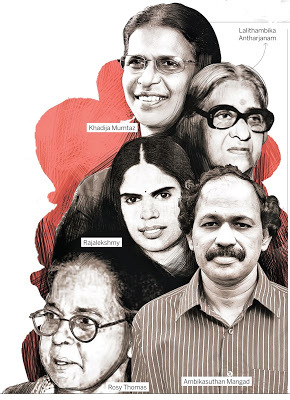
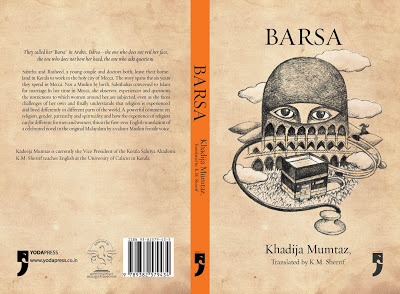 The translation project of Malayalam University is hoping for more financial support from the state government. The aim: to spread Malayalam literature all over the globe
The translation project of Malayalam University is hoping for more financial support from the state government. The aim: to spread Malayalam literature all over the globeIllustration by Shuvajit Dey
By Shevlin Sebastian
In October, 2016, K. Jayakumar was at the Malayalam University stall at the Frankfurt Book Fair. An American publisher walked in.
Immediately Jayakumar opened a map of India and pointed at Kerala and said, “The language of this state is called Malayalam. And we have a rich literature.” Then he showed a catalogue which consisted of 100 authors.
The American listened patiently. Later, Jayakumar said, “The Americans have no idea about Malayalam. They might know Kerala as a tourist destination but not as a destination with a rich literature.”
But Jayakumar has not lost hope. “Thanks to globalisation, there is an interest in lesser-known literature across the world,” he says. “So the plan is to promote Malayalam literature through English translations.”
With this end in mind, in late 2014, Jayakumar, as the then Chancellor of the Malayalam University set up a translation project, with himself as Chairman. And an advisory council was also selected. The members included K. Sachidananthan, Dr E V Ramakrishnan, Dr Jancy James, Dr J. Devika, Dr PP Raveendran, Dr M M Basheer, Dr T M Yesudasan, Dr K M Sherif and Mini Krishnan. It is a mix of noted writers, academicians and in Mini, an experienced publisher of translations.
However, when they approached English language publishers most were hesitant since they were not certain of assured sales. So an understanding was reached. The publisher would bring out the book, according to its norms, but the university would buy 300 copies of the first edition. “That would be enough to meet the cost of the printing,” says Jayakumar. “But we can only use the books for promotional purposes.”
In the end, six leading publishers accepted the proposal. They included Oxford University Press, Orient Blackswan, Navayana, Juggernaut, Women Unlimited and Yoda Press. “In 2018, Niyogi Books and Aleph Book Company have agreed to participate,” says Mini.
Thus far, six books have been published. The authors are: 'Swarga' by Ambikasutan Mangad; 'On the Far Side of Memory' – short stories of Lalithambika Antharjanam (both translated by J. Devika); 'A Path and Many Shadows & Twelve Short Stories' by Rajalekshmy (translated by RK Jayasree); 'He, My Beloved CJ' by Rosy Thomas (translated by G. Arunima); 'Barsa' by Khadija Mumtaz (translated by KM Sherrif) and a book of stories by Dali writers called 'Don't want caste' (translated by Abhirami Girija Sriram and Ravi Shankar).
As to how the choice of authors was done, Jayakumar says, “We looked for authors who have contemporary relevance. Both Lalithambika and Khadija have dwelt on woman's emancipation. As for Rajalekshy, none of her books has been published in English. We are the first. And we felt very happy when the first edition sold out and the publisher has gone in for a reprint. We have also selected based on the thought whether a foreigner can relate to the subject matter. I am sure our list cannot be beyond criticism. Selection of an author means rejection of another.”
At this moment, the committee has short-listed about 20 authors. “Mini is trying to harmonise the interest of the publisher as well as the university,” says Jayakumar.
As for the target audience, both in India and abroad, Jayakumar says, “We are looking for academic-oriented and serious readers. And there is also the vast Indian diaspora. Maybe, the second-generation Indian could be encouraged to read these books so that they can get an idea of their rich cultural heritage. This is an area that needs to be explored.”
But increasingly, the committee feels that they need more financial resources and support from the state government. And Jayakumar gave an example of government support. “Many Turkish authors are published in India,” he says. “And the reason is that the Turkish government is underwriting the cost of publication. So we will be approaching the state government for an increased financial commitment so that we can get more authors, more translators, more publishers and, eventually, more readers.”
(The New Indian Express, Kochi and Thiruvananthapuram)
Published on December 25, 2017 23:15
Anita Dube: On a Journey Through The Art World
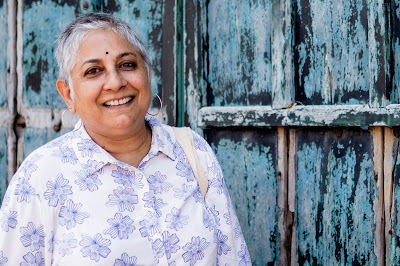 By Shevlin Sebastian
By Shevlin SebastianOn the phone from New Delhi, Anita Dube sounds rushed. But that is understandable. Ever since she was appointed as the curator of the fourth edition of the Kochi Muziris Biennale, which will begin in December, 2018, she has been on a series of travels.
Anita has been to Malaysia, Indonesia, Singapore, Vietnam and Thailand looking at the works of artists. “I am going to focus on the Global South for this Biennale – South-East Asia, Africa and Latin America,” she says. “But that does not mean that I will be excluding Europe. I have also been to Denmark, Austria, Germany, Sweden, Norway and other Nordic countries to meet up with artists.”
As for the theme, Anita says, “I would like to explore possibilities for a non-alienated human existence, as well as give opportunities to women, and those from the margins of society.”
Looking back, the appointment in March this year had been thrilling. “Firstly, because I am a woman,” she says. “Secondly, it will allow me to bring a feminist viewpoint to the Biennale.”
Asked whether she was intimidated, Anita says, “Not at all. But I did ask myself whether I was up to the task and did feel so.”
It has been an up-and-down journey so far. “That is the case when you are handling any big responsibility,” she says. “You do feel stressed out at certain moments, but at the same time, it has been such an enriching experience. I have seen so many wonderful art works and met some fascinating people.”
(Sunday Magazine, The New Indian Express, South India and Delhi)
Published on December 25, 2017 22:34
December 20, 2017
Director M. Padmakumar talks about his experiences in the films, 'Inspector Balram', 'Padavi', 'Oru Bolivian Diary', and 'Shikkar'
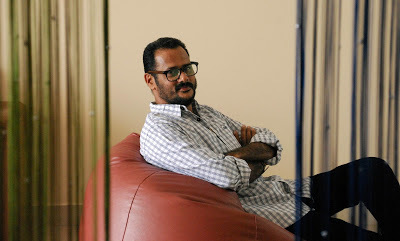 COLUMN: LOCATION DIARY
COLUMN: LOCATION DIARYPhoto by K. Shijith
By Shevlin Sebastian
In IV Sasi's 'Inspector Balram' (1991), the shoot for a major scene was supposed to take place on the main road of Thalaserry. It was of a procession with the police doing a lathi-charge. Mammootty was playing the hero. However, the moment people heard that he was present, a huge crowd gathered. It became impossible to shoot anything.
Nevertheless, Sasi kept his cool. He placed cameras at four different locations. Then he went up to the producer Liberty Basheer and said that the people had to be removed. Basheer nodded and informed the police.
Thereafter, a lathi-charge took place. “So, we got a real-life sequence,” says director M Padmakumar, who was working as an assistant director on the film.
What Padmakumar will never forget was the sight of numerous slippers that were strewn on the road, as the people struggled to get away. “We showed this scene, too,” he says.
In Sasi's 'Padavi' (1993), the shoot was taking place on a beach in Goa. One morning, everybody set out from the hotel. In the last vehicle sat assistant directors Shajoon Kariyal, Vinu Anand and Padmakumar. They had the script box with them.
Unfortunately, the driver did not know the name of the beach. So, they wandered from one beach to the other, trying to find the location. “There were no mobile phones at that time,” says Padmakumar. “So, there was no way we could contact the crew. We were feeling so tense because the shoot could not take place without the script.”
Anyway, by the time they reached the location, it was 5 p.m. The trio expected Sasi to blow his top. “But when he saw us, Sasi Chettan looked so relieved, because he thought that we were involved in an accident,” says Padmakumar. “Even the hero Rahman and the crew looked happy. So, it ended up fine, even though we lost a day of shooting.”
In 'Oru Bolivian Diary' (2013), there was a crisis of a different kind. The story is about a North Indian Maoist leader Chaukidar (played by Samuthirakani), who comes to preach his beliefs to the tribal people of Wayanad. Naturally, he is in the cross-hairs of the police. So, he takes refuge inside a temple, which was constructed with Plaster of Paris and plywood, in the middle of a river.
“This was a river, with little water, inside a forest, so that you could easily walk across,” says Padmakumar. The camera was kept on the shore. The shoot began. But soon, it started raining.
But Samuthirakani remained inside the temple with an assistant. Suddenly, the water began to rise up, till it became a raging force. “Then we realised that their lives were in danger,” says Padmakumar.
Two members of the art department tied a rope around a tree on the bank and then dived into the water and attached it to the pillar of the temple. Then Samuthirakani, who did not know swimming, held the rope tightly and managed to wade through the water, and reached the shore followed by the assistant.
The shoot was stopped for the day. The next morning when the crew came to the bank they saw that the temple had also been washed away. “So that was a close shave for our actors,” says Padmakumar. “We waited for the rains to stop, then managed to make another temple and completed the shoot.”
Like 'Oru Bolivian Diary', the shoot of the film, 'Shikkar' (2010) took place deep in the forest of Pooyamkutty. The crew had to travel on jeeps since there was no motorable road. One day, at 5 p.m., when they were returning in a convoy of 12 jeeps, the road was blocked by a group of elephants. Immediately, Mohanlal stepped out and said, “Be silent. Don't make a noise at all.”
One of the elephants had just given birth. “We watched as the calf tried to stand up and would fall down time and again,” says Padmakumar. The minutes ticked away. Soon, it became dark. The headlights were switched on. But the elephants remained calm. And it was only at 7.30 p.m. that the calf was finally able to stand up and walk. Thereafter, the herd moved away. “It was an unforgettable sight for all of us,” says Padmakumar.
(The New Indian Express, Kochi, Thiruvananthapuram and Kozhikode)
Published on December 20, 2017 22:07



